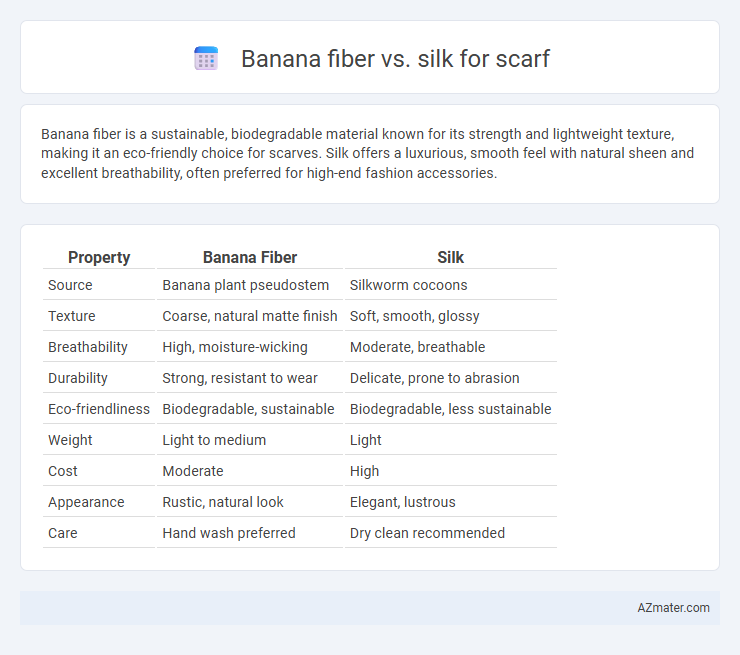Banana fiber is a sustainable, biodegradable material known for its strength and lightweight texture, making it an eco-friendly choice for scarves. Silk offers a luxurious, smooth feel with natural sheen and excellent breathability, often preferred for high-end fashion accessories.
Table of Comparison
| Property | Banana Fiber | Silk |
|---|---|---|
| Source | Banana plant pseudostem | Silkworm cocoons |
| Texture | Coarse, natural matte finish | Soft, smooth, glossy |
| Breathability | High, moisture-wicking | Moderate, breathable |
| Durability | Strong, resistant to wear | Delicate, prone to abrasion |
| Eco-friendliness | Biodegradable, sustainable | Biodegradable, less sustainable |
| Weight | Light to medium | Light |
| Cost | Moderate | High |
| Appearance | Rustic, natural look | Elegant, lustrous |
| Care | Hand wash preferred | Dry clean recommended |
Introduction: Banana Fiber vs Silk Scarves
Banana fiber scarves offer a sustainable, eco-friendly alternative to traditional silk with their natural durability and unique texture. Silk scarves are prized for their smooth, luxurious feel and vibrant color retention, making them a classic choice in high-fashion accessories. Both materials provide distinct advantages, where banana fiber emphasizes environmental benefits and breathability, while silk excels in elegance and softness.
Origin and Production Processes
Banana fiber originates from the pseudostem of the banana plant, primarily cultivated in tropical regions of Southeast Asia, where the fiber is manually extracted through a process of retting and scraping. Silk is produced from the cocoons of the Bombyx mori silkworm, predominantly farmed in countries like China and India, with fibers obtained through sericulture involving careful cultivation and harvesting of silk threads. The banana fiber production emphasizes sustainability and biodegradability, while silk production highlights labor-intensive sericulture and intricate reeling techniques.
Environmental Impact and Sustainability
Banana fiber, derived from agricultural waste, offers a biodegradable and renewable alternative to silk, which involves intensive water use and silkworm farming. Production of banana fiber minimizes chemical inputs and reduces deforestation risks, making it a more sustainable choice for eco-conscious consumers. Silk's slower biodegradability and reliance on animal agriculture contribute to a higher environmental footprint compared to the rapid compostability and lower resource demands of banana fiber.
Texture and Skin Feel
Banana fiber scarves offer a coarse texture with natural breathability, providing a slightly rough yet eco-friendly feel ideal for those seeking sustainable fashion. Silk scarves boast a smooth, luxurious texture characterized by a soft, lightweight touch that glides effortlessly over the skin, making them perfect for sensitive skin types. While banana fiber may feel more textured and rustic, silk delivers unparalleled softness and a gentle, cooling sensation against the skin.
Durability and Longevity
Banana fiber scarves exhibit exceptional durability due to their strong, coarse fibers that resist wear and tear, making them ideal for everyday use. Silk scarves, while luxurious and soft, are more delicate and prone to snagging and degradation over time, requiring careful handling to maintain their longevity. The natural strength of banana fiber ensures longer-lasting scarves that withstand frequent washing and environmental exposure better than silk.
Breathability and Comfort Level
Banana fiber offers superior breathability due to its natural moisture-wicking properties, making it ideal for warm climates. Silk provides a smooth, lightweight texture that enhances comfort by regulating temperature and feeling gentle against the skin. Both materials offer unique benefits, but banana fiber excels in airflow, while silk prioritizes softness and temperature control.
Visual Appeal: Colors and Patterns
Banana fiber scarves offer a natural matte finish with earthy tones that enhance subtle, organic patterns, appealing to eco-conscious fashion enthusiasts. Silk scarves exhibit a lustrous shine that intensifies vibrant colors and intricate designs, providing a luxurious and eye-catching appearance. The choice between banana fiber and silk for scarves depends on the desired visual effect--rustic elegance versus glossy sophistication.
Price and Affordability
Banana fiber scarves generally offer a more affordable price point compared to silk, making them accessible for budget-conscious shoppers. Silk scarves tend to be higher priced due to the labor-intensive production process and luxury appeal. The durability and eco-friendliness of banana fiber also contribute to its cost-effectiveness without sacrificing quality.
Care and Maintenance Requirements
Banana fiber scarves require gentle hand washing with mild soap and air drying to prevent weakening of the natural fibers, while silk scarves demand cold water cleaning and often dry cleaning to preserve their delicate structure and sheen. Both materials should be stored away from direct sunlight to avoid fading, but silk is particularly sensitive to moisture and oils, necessitating careful handling during wear. Proper care extends the lifespan of banana fiber and silk scarves, maintaining their texture and appearance for prolonged use.
Choosing the Best Scarf Material for You
Banana fiber scarves offer natural breathability, eco-friendliness, and a slightly coarse texture ideal for sustainable fashion lovers, while silk scarves provide unmatched softness, sheen, and luxurious feel perfect for formal or elegant occasions. Consider your skin sensitivity, climate, and style preference when choosing between banana fiber's durability and Silk's lightweight smoothness. Prioritizing hypoallergenic properties, moisture-wicking ability, and maintenance requirements will help determine the best scarf material tailored to your daily comfort and wardrobe versatility.

Infographic: Banana fiber vs Silk for Scarf
 azmater.com
azmater.com